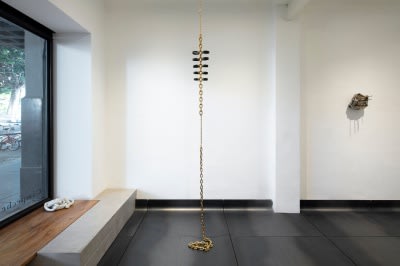Yeni Mao’s best-known works were surprisingly absent from his first solo show in Mexico City. His freestanding sculptures created from rigid industrial materials adorned with leather, minerals, chains, ceramics, and spikes have been shown in many pop-up shows and, last year, in a group exhibition at Museo Tamayo. Those pieces usually feature bright colors and exude an odd affect: they are sexy, BDSM-tinged, hung with whips and cuffs, and at the same time suggest a commentary on vernacular uses of materials. Mao, who studied art in Canada and has been based in Mexico City for a few years, seems obsessed with the Mexican tradition of plastering tile on surfaces and with the exposed rods on so many of the city’s buildings. The pieces were also heavy on negative space, with poles and wires framing emptiness, rocks and leather straps hanging in the air; their cage-like armatures evoked the often-unacknowledged restraints that architecture imposes on our bodies.
In Mao’s latest exhibition, at Campeche, his interest in local architecture and choice of primary materials remained steady, but the works’ forms were more oriented toward the past. At the center of the gallery sat fig 33.1-5 yerba mala (2021), a complex platform that emulates the shape of the many stepped pyramids in Mexico but is rendered in a series of dark steel modules that hold, support, and restrain additional elements comprising minerals, metal, leather, and ceramic. Whereas Mao’s prior works tended to stand around like lone, colorful, kinky individuals, this sculpture involves more interconnected pieces and a more dynamic collective stance. At the very front sits a massive teal cat’s paw, claws out. Behind it, a few of the modules hold gold- and nickel-plated volcanic rocks, perhaps Central Mexico’s most abundant material. Other garnishes include leather straps, but the ceramic elements are the most striking. A steel platform in the middle of the work suspends two bulbous, lunglike forms made of red ceramic punctured by white braces that have a clinical flair. At the very back, a curved cylindrical form in black and white with spiky fins dangles from another module. Above it is another teal paw with the menacing detail of a pinky nail replaced by sharp metal. Mao’s pyramid comes to articulate a body, but a nonhuman one: the almighty jaguar of so many Mesoamerican legends. It’s as if the restricted body of previous works has come into newfound power—within, or in spite of, certain constraints.
The rest of the show displayed Mao’s further experiments with his roster of materials. Fig 33.6 to lay in the great city (2022) is a beautifully detailed gold-plated chain that hung from the ceiling and coiled on the floor, featuring five pairs of leather cuffs at the top. Continuing this formal thread are a knot of two white ceramic snakes evocatively titled fig 27.3 i’m never like this when i’m not with you (2022) and a black serpent dangling from its midsection in a punitory fashion, coiling on itself, almost bashful. Mao’s allusions to highly symbolic mythical creatures—great felines, snakes—juxtaposed with the material and literal vocabulary of sex play, seemed to posit the possibility that knowledge can be found, or made, in the ungoverned experiencing of our bodies, inside and out.

YENI MAO, FIG 33.6 TO LAY IN THE GREAT CITY, 2022, GOLD-PLATED, STEEL, LEATHER, HARDWARE, 140 BY 8 BY 3 INCHES. PHOTO RAMIRO CHAVES/COURTESY THE ARTIST AND CAMPECHE
A weird addition to the group was fig 32.01 blossom (2021), a series of organic-looking, pink ceramic plates that covered a column in the gallery. The pieces’ fleshy texture, holes, and sprouting horns suggest an experiment gone wrong, like impulse-buying a new lotion and ending up with a rash. Given its mix-and-match collection of objects, Mao’s show felt transitional, a stage between his bleary-eyed obsession with local construction and design and a more experimental approach to its materials. The latest sculptures, although their internal juxtapositions are sometimes hard to read, seem intended to balance future embodied desires with past built aesthetics.
© 2022 PMC. All rights reserved.

